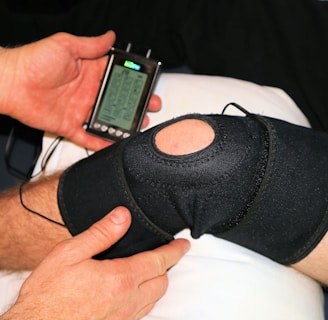Post-Exercise Recovery Performance with Muscle Stimulation
As athletes and fitness enthusiasts continually seek ways to enhance their performance and recover more efficiently, innovative technologies like muscle stimulation have gained popularity. Muscle stimulation, also known as neuromuscular electrical stimulation (NMES), involves the application of electrical impulses to the muscles to induce contractions. In this blog article, we will explore how muscle stim can be a game-changer in post-exercise recovery, helping individuals achieve optimal performance.
Macoy
1/22/2024


1. Understanding Muscle Stimulation:
One of the key benefits of muscle stimulation in post-exercise recovery is its ability to improve blood circulation. The electrical impulses generated during muscle stimulation cause muscles to contract, aiding in the pumping of blood throughout the body. This increased circulation helps deliver essential nutrients and oxygen to muscle tissues, accelerating the recovery process.
4. Muscle Recovery and Repair:
Delayed onset muscle soreness (DOMS) is a common post-exercise issue that can hinder performance and deter individuals from sticking to their workout routines. Muscle stimulation has been shown to alleviate muscle soreness by promoting the release of endorphins, the body's natural painkillers. This can result in a quicker recovery turnaround, allowing individuals to return to their training with less discomfort.
One notable advantage of muscle stimulation is its ability to target specific muscle groups. This precision in muscle activation can be particularly beneficial for athletes recovering from injuries or focusing on specific muscle imbalances. By selectively activating muscles, individuals can address weaknesses and promote overall muscle balance, reducing the risk of future injuries.
5. Targeted Muscle Activation:
Muscle stimulation can expedite the muscle recovery and repair process by promoting the production of growth factors. These growth factors play a crucial role in the regeneration of damaged muscle tissue. As a result, individuals incorporating muscle stimulation into their recovery routine may experience faster healing of micro-tears caused by intense exercise.
3. Reduction of Muscle Soreness:
Muscle stimulation works by sending electrical impulses to the nerves that control muscle contraction. These impulses mimic the signals that the brain sends to the muscles during physical activity. By doing so, muscle stimulation can engage muscle fibers and promote blood circulation without the need for voluntary movement.
2. Enhanced Blood Circulation and Nutrient Delivery:
My Top 3 Muscle Stim Products
Muscle stimulation devices have become increasingly accessible for home use, providing individuals with the convenience of incorporating this technology into their daily routine. This accessibility allows for more frequent and consistent use, maximizing the benefits of muscle stimulation for post-exercise recovery.
6. Convenience and Accessibility:
Conclusion:
As the demand for effective post-exercise recovery methods continues to grow, muscle stimulation emerges as a promising solution. By enhancing blood circulation, reducing muscle soreness, promoting muscle recovery, and offering targeted muscle activation, muscle stimulation can be a valuable tool in the pursuit of optimal performance. As technology advances and research in this field expands, integrating muscle stimulation into a well-rounded recovery strategy has become a standard practice for athletes and fitness enthusiasts.
Contact
macoy@athletehacks.com
